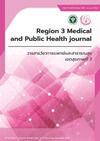ความสัมพันธ์ระหว่างผลการทดสอบสมรรถภาพทางกายด้วยการลุกนั่ง 30 วินาทีและการเดิน 6 นาที ในผู้ป่วยโรคหลอดเลือดหัวใจที่เข้ารับการฟื้นฟูสมรรถภาพหัวใจระยะที่ 2 โรงพยาบาลสวรรค์ประชารักษ์ จังหวัดนครสวรรค์
คำสำคัญ:
โรคหลอดเลือดหัวใจ, การเดิน 6 นาที, การลุกนั่ง 30 วินาที, การฟื้นฟูสมรรถภาพหัวใจบทคัดย่อ
วัตถุประสงค์: เพื่อศึกษาความสัมพันธ์ระหว่างผลจากการทดสอบสมรรถภาพทางกายด้วยการลุกนั่ง 30 วินาที (30-second sit-to-stand test: 30-s STS) และการเดิน 6 นาที (6-minute walk test: 6MWT) ในผู้ป่วยโรคหลอดเลือดหัวใจที่เข้ารับการฟื้นฟูสมรรถภาพหัวใจระยะที่ 2
วิธีการศึกษา: การศึกษาแบบตัดขวาง (Cross sectional study) ในผู้ป่วยที่ได้รับการวินิจฉัยและรักษาโรคหลอดเลือดหัวใจด้วยวิธีการสวนหลอดเลือดหัวใจ (Percutaneous Coronary Intervention: PCI) หรือผ่าตัดทำทางเบี่ยงเลือดหัวใจ (Coronary Artery Bypass Grafting: CABG) และเข้ารับการตรวจติดตามฟื้นฟูสมรรถภาพหัวใจระยะที่ 2 แบบผู้ป่วยนอกในโรงพยาบาลสวรรค์ประชารักษ์ โดยวิธีการศึกษาให้ผู้เข้าร่วมการทดสอบทุกรายทดสอบสมภาพทางกายด้วยวิธี 6MWT ก่อน หลังจากนั้นให้นั่งพักจนหายเหนื่อย แล้วทดสอบด้วยวิธี 30-s STS บันทึกผลการทดสอบได้แก่ ค่าความดันโลหิต อัตราการเต้นหัวใจ ระดับความเหนื่อย (Rate of perceived exertion: RPE) ค่าความเข้มข้นของออกซิเจนในเลือด (Oxygen saturation) ระยะทางที่ได้จากการประเมิน 6MWT และ จำนวนครั้งที่ลุกยืนได้จากการประเมิน 30-s STS
ผลการศึกษา: จากผู้เข้าร่วมการทดสอบทั้งหมด 30 ราย ค่าสัญญานชีพที่วัดได้หลังการทดสอบทั้งสองวิธีไม่พบความแตกต่างกันอย่างมีนัยสำคัญ และเมื่อคำนวนค่าสัมประสิทธิ์สหสัมพันธ์ (Correlation coefficient) (r) ระหว่างระยะทางที่ได้จากการประเมิน 6MWT และ จำนวนครั้งที่ลุกยืนได้จากการประเมิน 30-s STS ได้เท่ากับ 0.72 (p-value <0.01) บ่งบอกว่ามีความสัมพันธ์กันอยู่ในระดับสูง
สรุป: การทดสอบสมรรถภาพทางกายด้วยการลุกนั่ง 30 วินาที (30-s STS) อาจใช้เป็นทางเลือกเพิ่มเติมจาก 6MWT ในการทดสอบสมรรถภาพทางกายในผู้ป่วยที่เข้ารับการตรวจติดตามฟื้นฟูสมรรถภาพหัวใจแบบผู้ป่วยนอกระยะที่ 2 ซึ่งได้รับการวินิจฉัยและรักษาโรคหลอดเลือดหัวใจ
คำสำคัญ: โรคหลอดเลือดหัวใจ, การเดิน 6 นาที, การลุกนั่ง 30 วินาที, การฟื้นฟูสมรรถภาพหัวใจ
เอกสารอ้างอิง
Araya-Ramírez F, Briggs KK, Bishop SR, Miller CE, Moncada-Jiménez J, Grandjean PW. Who is likely to benefit from phase II cardiac rehabilitation? Journal of cardiopulmonary rehabilitation and prevention. 2010;30(2):93-100.
Piepoli MF, Corrà U, Benzer W, Bjarnason-Wehrens B, Dendale P, Gaita D, et al. Secondary prevention through cardiac rehabilitation: from knowledge to implementation. A position paper from the Cardiac Rehabilitation Section of the European Association of Cardiovascular Prevention and Rehabilitation. Eur J Cardiovasc Prev Rehabil. 2010;17(1):1-17.
Bellet RN, Adams L, Morris NR. The 6-minute walk test in outpatient cardiac rehabilitation: validity, reliability and responsiveness--a systematic review. Physiotherapy. 2012;98(4):277-86.
Wang Z, Yan J, Meng S, Li J, Yu Y, Zhang T, et al. Reliability and validity of sit-to-stand test protocols in patients with coronary artery disease. Front Cardiovasc Med. 2022;9:841453.
Meriem M, Cherif J, Toujani S, Ouahchi Y, Hmida AB, Beji M. Sit-to-stand test and 6-min walking test correlation in patients with chronic obstructive pulmonary disease. Ann Thorac Med. 2015;10(4):269-73.
Reychler G, Boucard E, Peran L, Pichon R, Le Ber-Moy C, Ouksel H, et al. One minute sit-to-stand test is an alternative to 6MWT to measure functional exercise performance in COPD patients. Clin Respir J. 2018;12(3):1247-56.
Díaz-Balboa E, González-Salvado V, Rodríguez-Romero B, Martínez-Monzonís A, Pedreira-Pérez M, Cuesta-Vargas AI, et al. Thirty-second sit-to-stand test as an alternative for estimating peak oxygen uptake and 6-min walking distance in women with breast cancer: a cross-sectional study. Support Care Cancer. 2022;30(10):8251-60.
Anderson L, Oldridge N, Thompson DR, Zwisler AD, Rees K, Martin N, et al. Exercise-Based Cardiac Rehabilitation for Coronary Heart Disease: Cochrane Systematic Review and Meta-Analysis. J Am Coll Cardiol. 2016;67(1):1-12.
ATS statement: guidelines for the six-minute walk test. Am J Respir Crit Care Med. 2002;166(1):111-7.
Evans JD. Straightforward statistics for the behavioral sciences. Belmont, CA, US: Thomson Brooks/Cole Publishing Co; 1996. xxii, 600-xxii, p.
Carvalho LP, Di Thommazo-Luporini L, Aubertin-Leheudre M, Bonjorno Junior JC, de Oliveira CR, Luporini RL, et al. Prediction of Cardiorespiratory Fitness by the Six-Minute Step Test and Its Association with Muscle Strength and Power in Sedentary Obese and Lean Young Women: A Cross-Sectional Study. PloS one. 2015;10(12):e0145960.
Muoneme AS, Isiguzo GC, Iroezindu MO, Okeahialam BN. Relationship between Six-Minute Walk Test and Left Ventricular Systolic Function in Nigerian Patients with Heart Failure. West Afr J Med. 2015;34(3):133-8.
Rosu AM, Badea TG, Tomescu FL, Rosu AL, Radu ES, Popa OA, et al. Clinical and Electrocardiographic Predictors of Cardiac Resynchronization Therapy Response That Correlate with the 6 min Walking Test. J Clin Med. 2024;13(20).
ดาวน์โหลด
เผยแพร่แล้ว
วิธีการอ้างอิง
ฉบับ
บท
การอนุญาต
ลิขสิทธิ์ (c) 2025 Region 3 Medical and Public Health Journal - วารสารวิชาการแพทย์และสาธารณสุข เขตสุขภาพที่ 3

This work is licensed under a Creative Commons Attribution-NonCommercial-NoDerivatives 4.0 International License.




